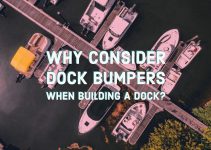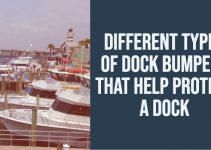You’ve got a dock or pier. It looks fantastic and it does its job well. Now… how do you make sure it stays that way?
Critical to the stability and longevity of fixed or stationary docks and piers is the pier pilings and posts.
In order to protect your dock or pier investment, it’s vital to understand how these can become damaged and why pier protection is necessary to prevent such damage.
Dock piers and posts can take on damage in many different ways:
- First, weather and water action can eat away at these wood pilings making them look unattractive, becoming a hazard to boats and swimmers, and even decrease in strength and stability.
- Second, the dock and pier pilings can be harmed by people and the things we play with near them For example, boats and other watercraft can cause harm by banging into them either once — hard — or in an aggregate manner over time.
- Marine life can hurt these dock piers and posts too. Shipworms specifically, are water-dwelling, wood boring, and wood-eating “worms.” Unfortunately, standard pesticides don’t work on Shipworms because they aren’t really insects—they’re saltwater-based only and use gills to breathe. Yet, they’re so dangerous to wood piers and posts that some mariners and marine contractors refer to them as “sea termites” since their behavior is similar. They will bore and bore into the wood of dock piers and posts until there is very little wood left at all. There have even been many occasions where Shipworm damage will go unnoticed until the dock just collapses into the water due to severely degraded piers and posts.
How can you protect your dock piers and posts in the best manner?
Marine pile bumpers can be a great solution to prevent physical damage to dock piers and posts.
The most common types of these pile bumpers are foam bumpers and pier pile protection fenders.
Pier pole foam bumpers are exactly what they sound like—high-density foam marine bumpers that protect the poles from external damage. Pier fenders are pretty much the same thing but can be made of wood, steel, concrete, or other synthetic compounds and cause objects to deflect off the fenders instead of pier piles and posts taking the brunt of direct hits.
Aside from physical strikes or hits that can cause aesthetic and structural damage, dock protection bumpers and fenders provide a slight bit of protection from UV damage too. But that’s really it—all they really do. They only protect the wood underneath of the very small surface area they cover. In short, they are really only intended to protect the dock from physical contact of some sort.
Piling Sleeves or Dock Piling Wrap: A Sound Investment When Building a Dock?
Both piling sleeves and dock piling wrap are more comprehensive dock post and pier protection options.
Pile sleeves usually consist of a PVC-type coating that is heat shrunk professionally around a dock post. If pile sleeves are installed over the entire pier before the posts are put into the water, it’s done at the lumber yard. In this case, it will often look like the pole is painted and possibly, not even like it is wood underneath.
As you can likely imagine, this can be a very costly option and must be done before the dock poles are installed on site. Therefore, pile sleeves will generally only be put on new docks with new piers or if piers are being totally replaced. A common brand name of pile sleeves is “DuroSleeve.” And while this is obviously a very comprehensive and durable pile protection option, it is also a very costly option. Thus, piles sleeves are usually reserved for the most upscale homes and docks OR as pier post protection for commercial docks and piers.
Another type of piling sleeve that can work well but is also time-intensive and a bit complicated to install, while also costly, is SnapJacket.
There are some pretty big benefits to SnapJacket but because of its price tag and the fact that the SnapJacket(s) have to be professionally installed, this option is usually reserved for serious cases to fix dock pier and post damage that has already occurred and where it’s not feasible — or it’s cost-prohibitive — to replace the piles.
A SnapJacket is a pretty “total pier protection solution” after it’s been placed on the poles. The product itself lives up to its name—it’s composed of two pieces of fiberglass that make up a “jacket” that snaps onto the entire dock post.
After the SnapJacket has been put on the poles, then concrete is poured into the space between the SnapJacket and the pole itself. Kind of cool is that the concrete will also seep into — and fill — damaged areas of the post as well. Again, SnapJacket isn’t really a cheap or even inexpensive option and not necessarily “pretty” but it does work pretty awesomely when the damage to dock piers and posts has already been done.
Another option for dock pier and post protection that is affordable for most people and that works really well to protect from environmental and biological damage, as well as from structural impact to a degree, is pile wrap.
Interested in the benefits of pier and post wrap over other piling protection choices?
A really cool thing about pile wrap as well, is that it protects boats and watercraft that might bump the pier post from damage too!
Pile wrap is typically made of some sort of black vinyl sheeting that comes in rolls and is literally “wrapped” around the pier post and secured with (usually) stainless steel nails. The wrap will extend from slightly above the waterline, to below the mudline. This span is where most of the damage would naturally occur.
In the majority of cases, pier pile wrap will be installed on pier posts before they are placed in the water. Yet, while this is the easiest method of pile wrap installation, many pile wrap options can be put on pier posts that have been in place for some time IF you can get the posts pretty clean before installation.
Once pile wrap has been put in place on dock piers and posts, it protects them in many ways. Obviously, there is a degree of protection from marine organisms and water/wave action at the surface. It’s also UV-resistant, while preventing UV damage to the parts of the posts covered. Thus, even though it’s not a total pier protection solution like pile sleeves, it can help extend the life of a dock and is a much more affordable option for most people.
Wondering where you might find pier and post pile wrap?
You might find a few different types of dock pier and post pile wrap on the market. And many of them will likely be somewhat similar. However, we have found the most superior product to be Pier Protector.
Pier Protector is a hearty, recycled HDPE-plastic pier protection option that is nice to look at while also working extremely well at its intended job of dock and pier piling protection. It’s super-durable too—essentially, lasting a lifetime.
Yet, even though it’s a beefy material, it’s fully moldable, bending easily to your pole size and shape. Pier Protector can be added pre-dock-installation or later. It can even be added after there has been a bit of damage to posts if you can get the post fairly clean.
How does Pier Protector work specifically?
How does Pier Protector work?
To reiterate, Pier Protector is made of heavy-duty HDPE plastic. It’s an attractive, dark, marine black color and it comes in a roll. You will select and purchase your desired length of Pier Protector and then you will cut the specific size pieces you need for your pier poles and posts.
The Pier Protector strips you’ve cut are then wrapped around the posts and held in place with stainless steel nails. You’ll leave a small portion of the Pier Protector strip above the water—which is where Shipworms do their damage and where posts would be damaged by other physical damage too.
As mentioned above, you can install Pier Protector on new dock piles and posts or pilings that have been in the water for some time. Again, you CAN usually use Pier Protector even if the posts have degree of damage that has already been done. If that’s the case, you’ll just need to clean them first, before putting on the pile wrap. After installation, the covered pier posts should last you for many more years to come before you would even need to consider total pile replacement.
Obviously, it’s always better to plan ahead when it comes to dock pier and post protection.
However, sometimes you move into a situation where this sort of protection just wasn’t well thought-out. Or perhaps you yourself just didn’t consider this potential pitfall in advance.
The good news is that even if you didn’t or don’t install Pier Protector or another pile protection option before the dock is in the water, in most cases, it’s not too late to rectify the problem. And unless your damage is just super-bad, you can often implement a solution like Pier Protector without spending a fortune.
Sure, addressing dock pier damage or adding in a protective pier piling solution is a little additional expense that you may not have been expecting. On the other hand, this is one investment that will likely return its value multiple-fold by lengthening the lifespan of your dock—sometimes significantly.
If you’re looking for the best in pier post protection for your residential home dock, we’d love for you to give Pier Protector a try!



